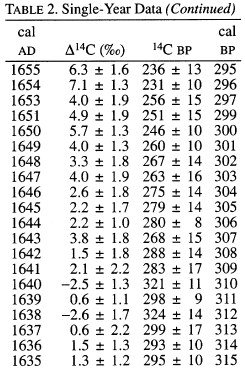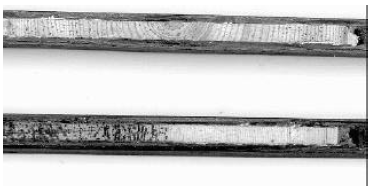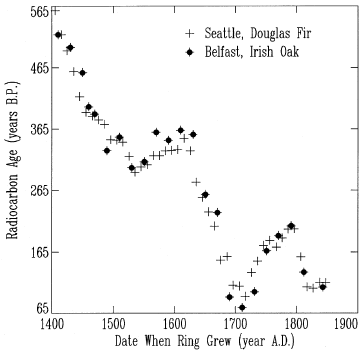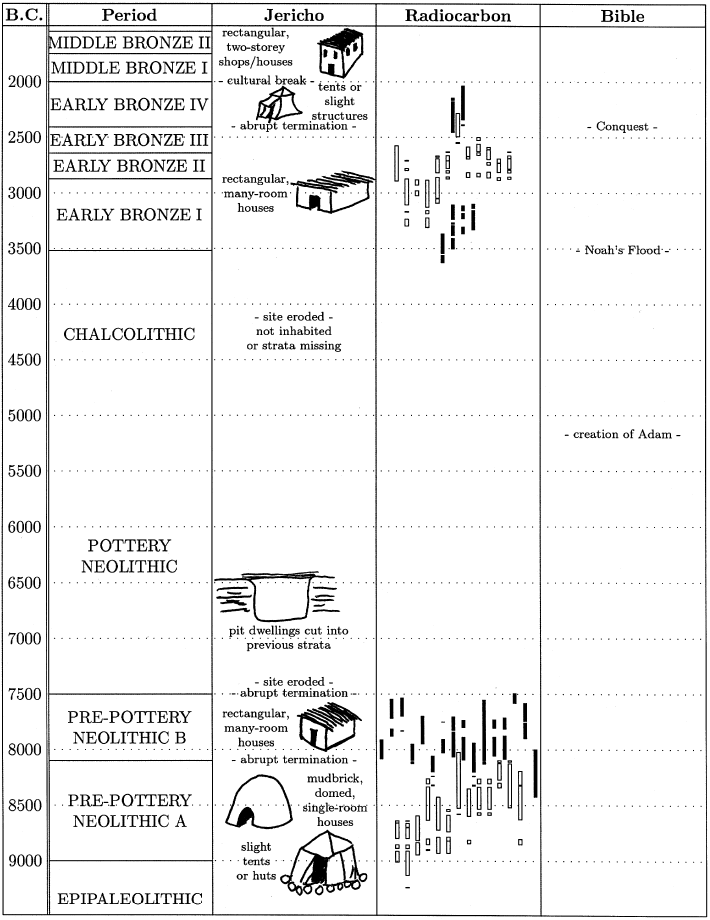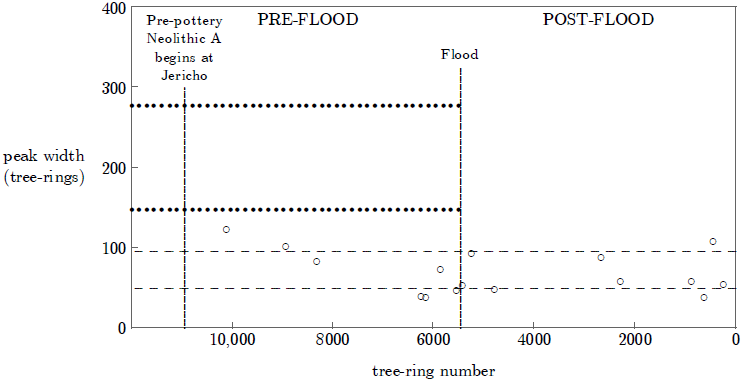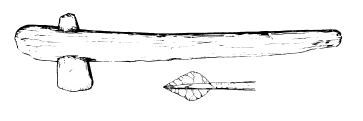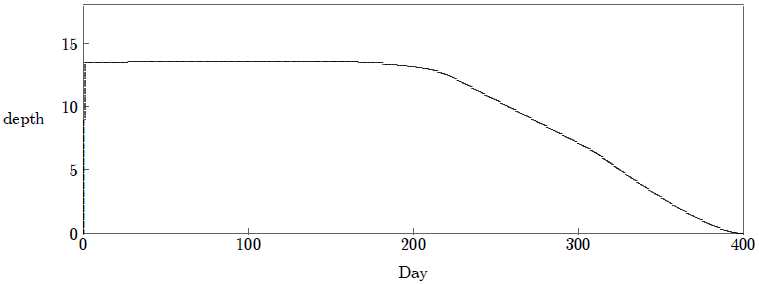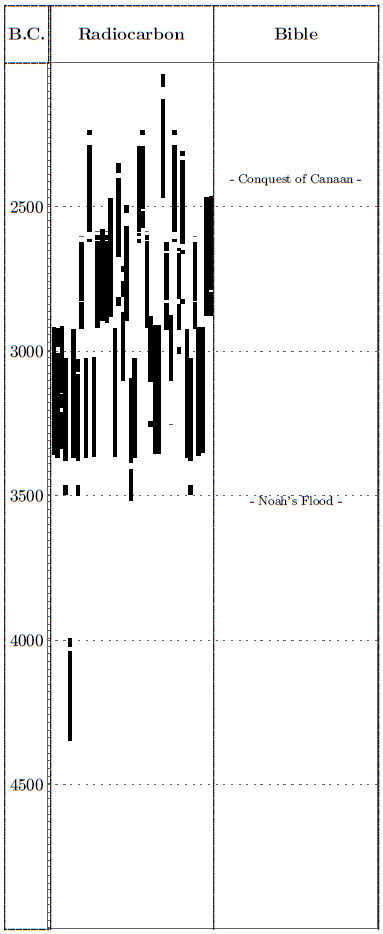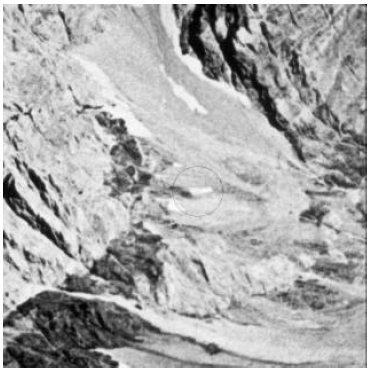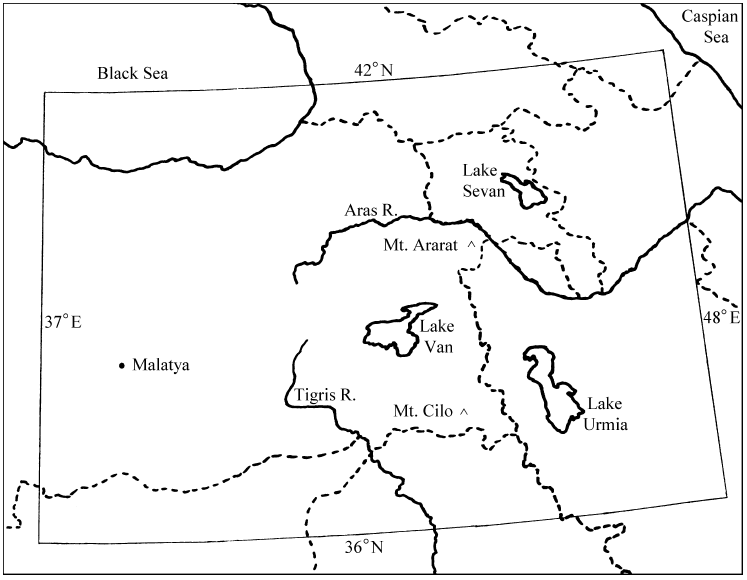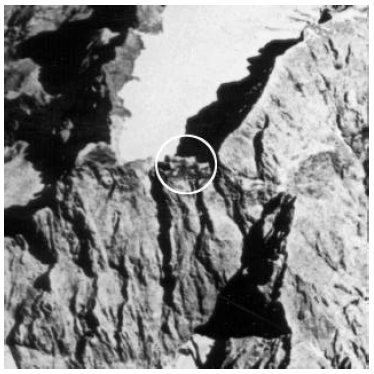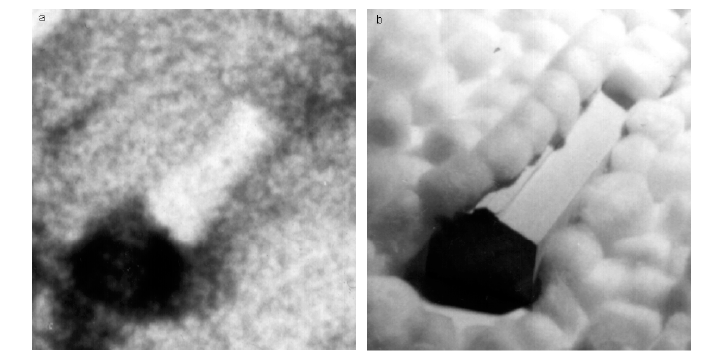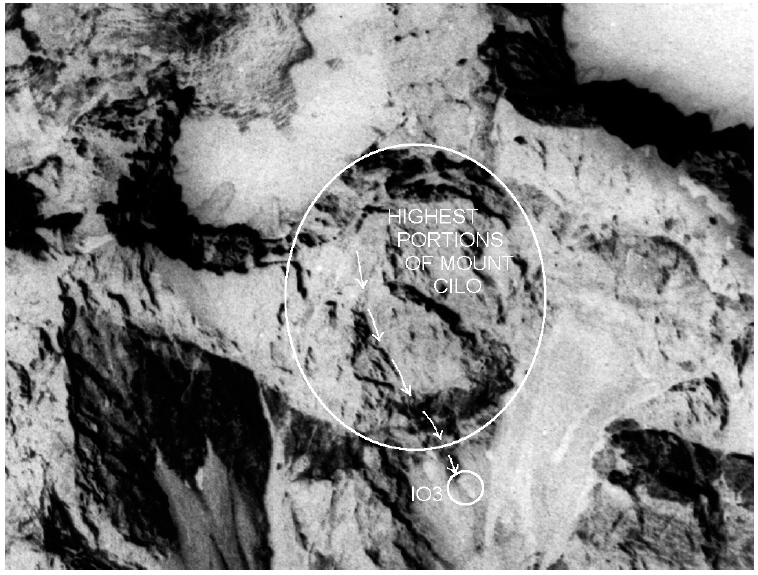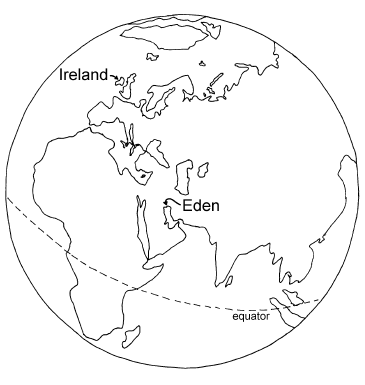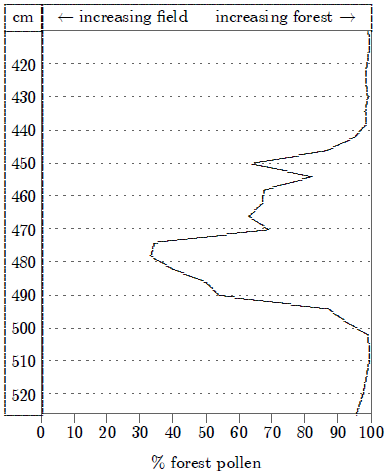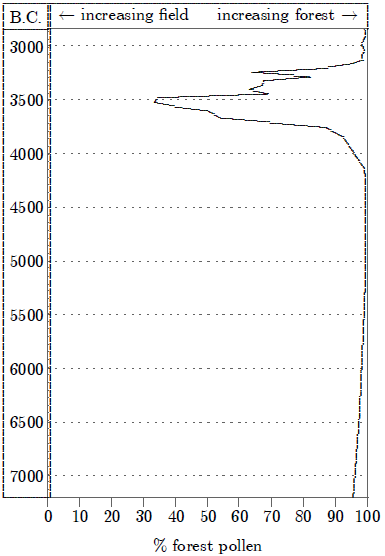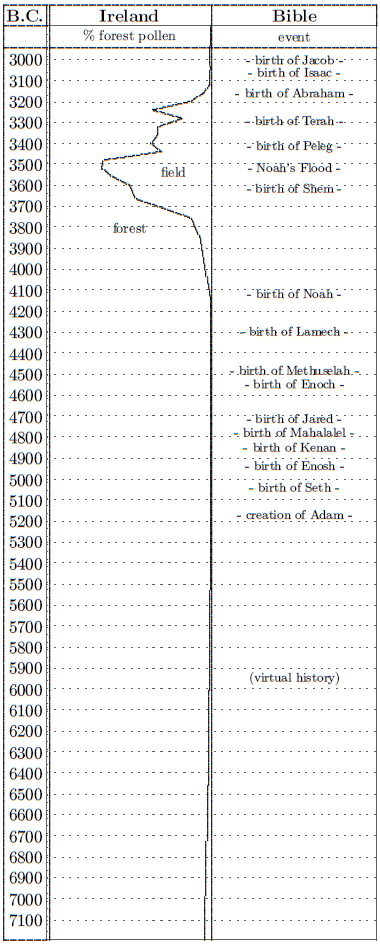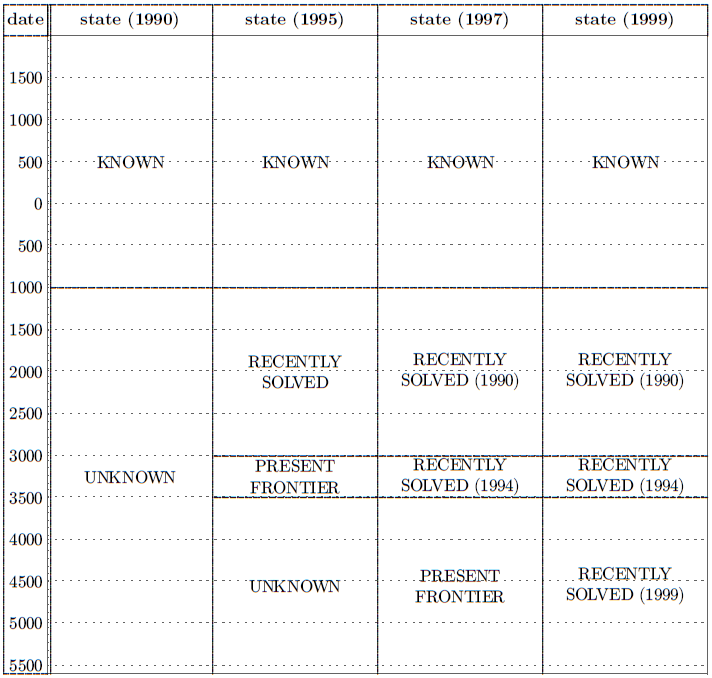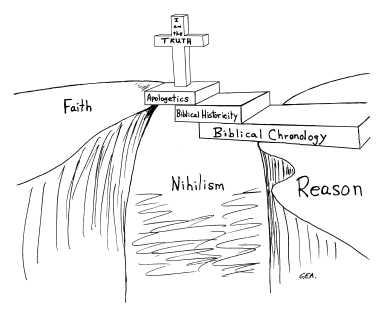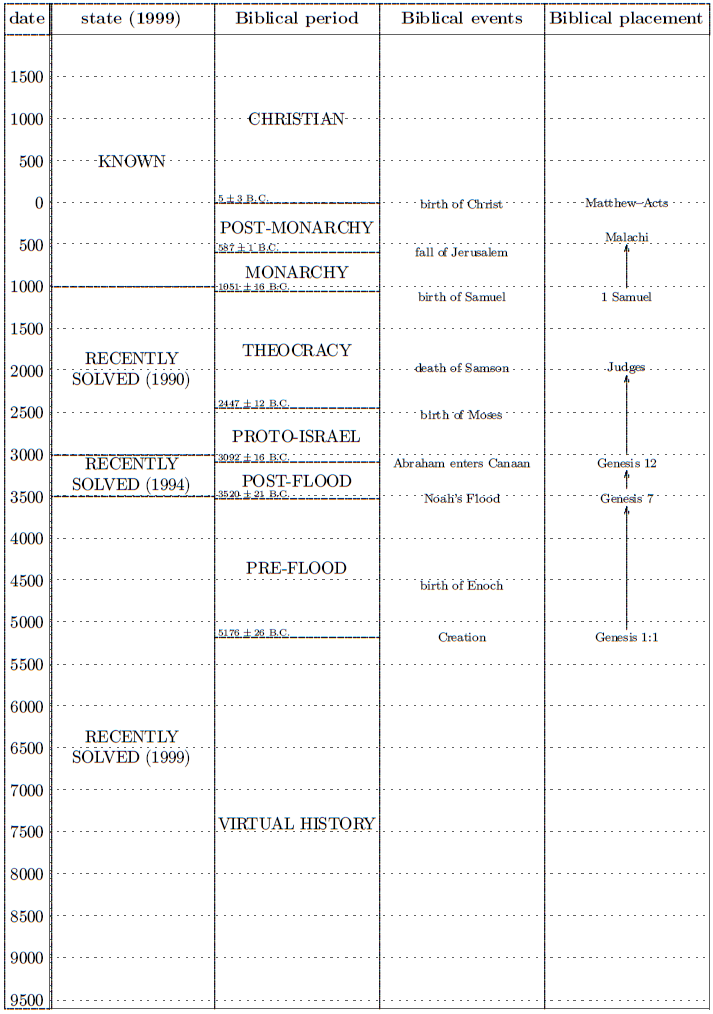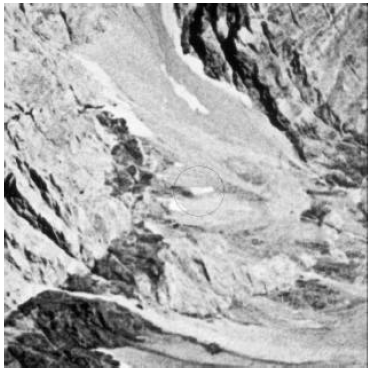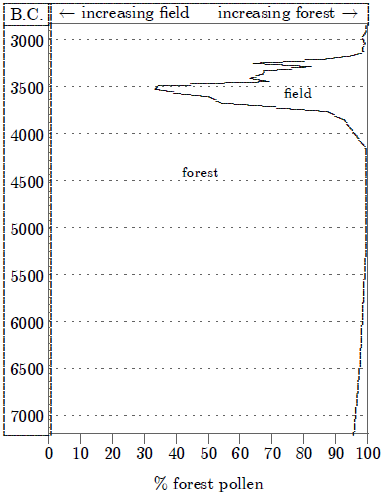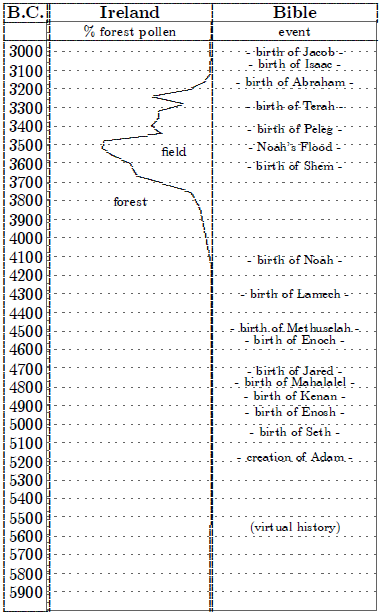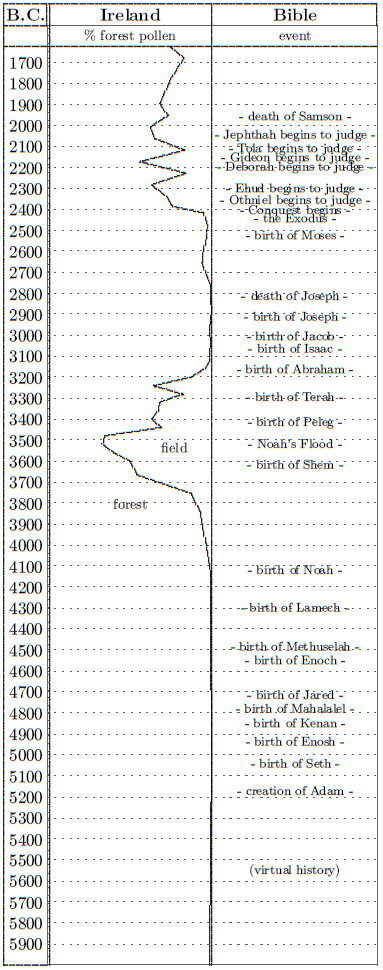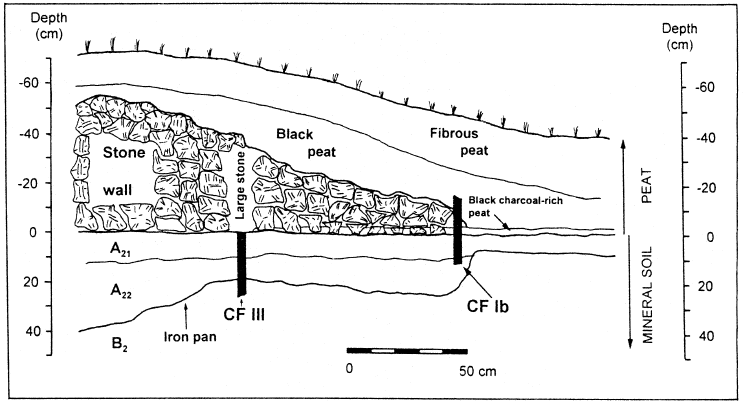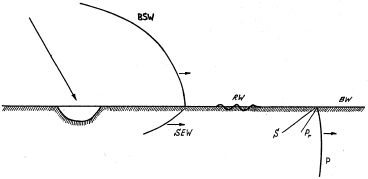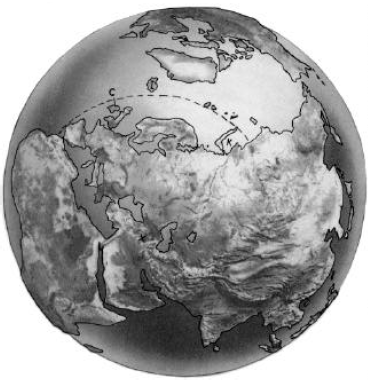 |
| Volume 5, Number 2 | March/April 1999 |
A Unification of Pre-Flood Chronology
The present article is the culmination of five consecutive articles dealing with the problem of the unification of sacred and secular chronologies in the pre-Flood era.[1] It presents a new solution of this longstanding problem.
Review
Once the missing thousand years in 1 Kings 6:1 is recognized and allowed for, sacred and secular chronologies of earth history exhibit essential unity from the present back until the creation of Adam, roughly 5200 B.C.[2] At that point in time one encounters the "central conundrum" of Pre-Flood Biblical chronology, which is the apparent existence of mankind, according to secular scholarship, many thousands of years before the creation date of Adam determined from Biblical chronology.[3] One must somehow resolve this conundrum before sacred and secular chronologies can be unified in the period of time prior to the creation of Adam.
I have enumerated nine conceptually possible solutions to this conundrum. I believe these nine exhaust the possibilities.[4]
The Biblical chronological data leading to the creation of Adam are false (i.e., fabricated).
The secular chronological data leading to a great antiquity for mankind are false (i.e., fabricated).
The Biblical history which teaches that Adam was the first man to be created is mythological or otherwise fabricated.
The modern secular teaching that mankind existed in remote antiquity is a hoax or fabrication.
We have misunderstood the Biblical history of the creation of Adam; the Bible does not really teach that Adam was the first man ever to be created.
The archaeologists have misunderstood the history of mankind; archaeology does not really show the existence of humans before Adam.
We have made some mistake in the computation of the Biblical date of the creation of Adam (i.e., the basic Biblical chronological data are valid, but they have been misunderstood).
The secular chronologists have made some mistake in their computation of the antiquity of man (i.e., the basic secular chronological data are valid, but they have been misunderstood).
The Biblical and secular evidences must both be accepted as legitimate; the truth lies in a proper synthesis of the two.
I have argued that the first eight of these conceptually possible solutions fail to present an adequate resolution of the central conundrum.
[5] Only the ninth possible solution remains.
The Problem
The ninth conceptually possible solution demands that both the Biblical and secular evidences regarding the antiquity of mankind be accepted as legitimate. To treat the ninth possible solution fairly in its own right one must deliberately put aside whatever lingering doubts they may have regarding the Biblical or the secular evidences bearing on the antiquity of mankind. One must no longer suppose that the sacred or secular chronological data are somehow fabricated or misunderstood. One must forsake the notion that the Biblical account of the creation of Adam is fictitious or abstruse. One must leave behind the idea that the archaeological data for pre-Adamic mankind are fabricated by the archaeologists, or that these data have somehow been misunderstood by the specialists who study them. All such intellectual baggage, no matter how comfortably threadbare, must be dropped at the threshold of the ninth conceptually possible solution, or one is self-condemned to remain outside its door.
For the ninth solution one must take as a starting assumption that the plain-sense, traditional view of Genesis is an accurate representation of the factual history the text means to communicate. That is, we are assuming at the outset that Adam was the first man ever to have been created, and that he was created only about seven thousand years ago (5176±26 B.C. according to modern Biblical chronology[6]). At the same time we are assuming that the normal, secular, text-book reconstruction of pre-history is reasonably accurate. Specifically, we are assuming that the physical data which have been dug from the ground really do show an unbroken continuity of humanity from the present into the very remote past, many thousands of years before the creation of Adam. Succinctly stated, for solution number nine we take as our departure point two Grand Facts:[7]
Grand Fact 1 Adam was the first human ever to have existed.
Grand Fact 2 Human remains and artifacts exist which greatly predate Adam.
The problem which is posed for the ninth possible solution is not how one might discard one or the other of these Grand Facts. Rather, it is, having accepted both, how to synthesize the two into a single, comprehensible whole.
The Difficulty
On the face of things this problem seems impossible to solve. The difficulty is that these two Grand Facts seem to say opposite things. Grand Fact 1, that Adam was the first human ever to have existed, establishes a point in time, 5176±26 B.C., before which there were no humans in existence. It states that the world was completely devoid of humans from the first instant of its creation up to and including the creation of Adam. Meanwhile Grand Fact 2, that human remains and artifacts exist which greatly predate Adam, implies a continuity of human existence on Earth from a very remote antiquity (at least 25,000 years ago, as we have previously discussed[8]) down to the present time. This continuity of human existence—including evidence of villages, pottery manufacture, burial of the dead, and much more—continues with no apparent break right through 5176±26 B.C. Recall, for example, that the creation of Adam appears to fall in the middle of the Ubaid period in Mesopotamia[9]. This "Ubaid period" is just archaeological jargon summarizing the continuous succession of settlements and agricultural villages found by the archaeologists in Southern Mesopotamia, beginning probably prior to 6000 B.C., and certainly long before 5176±26 B.C., and continuing in an unbroken chain of human culture to somewhere in the vicinity of 4400 B.C. How, then, can these two Grand Facts possibly be reconciled?
Certainly it is the case that if one assumes that history is comprised of an unbroken chain of naturalistic cause and effect phenomena, then no reconciliation of these two Grand Facts of any sort appears. But this is hardly surprising, for the assumption of an unbroken chain of naturalistic cause and effect is just a denial of Grand Fact 1. Grand Fact 1 demands the supernatural creation of Adam at the outset, and this demand cannot be reconciled with any assumed unbroken chain of naturalistic cause and effect phenomena into eternity past. To cross the threshold into solution number nine, one must leave the wearisome philosophical baggage of naturalism behind.
And strange though it may seem, once one has done so, a rational way of reconciling these two Grand Facts does appear.
The Solution
Logically, synthesis of these two Grand Facts can be accomplished if we accept that the evidence for humans prior to Adam only came into existence subsequent to the creation of Adam, as shown in this time-line.
That is, these two Grand Facts can be reconciled if and only if Grand Fact 2 only became operable (i.e., began to be true) at some point in time after Grand Fact 1 had become operable. To see this we proceed deductively as follows.
Grand Fact 1 establishes a point in time, 5176±26 B.C. according to our best modern reckoning, before which no humans were in existence. Grand Fact 2 implies continuity of human populations before, during, and after that time. If Grand Fact 2 were in operation at the time of Adam's creation, then other humans besides Adam would have been in existence at the time of Adam's creation. In that case Adam would not have been the first human ever to have existed, and Grand Fact 1 would be violated. Thus, Grand Fact 2 could not have been in operation at the time of the creation of Adam.
If, on the other hand, Grand Fact 2 only began to operate subsequent to the creation of Adam, then Adam would be, in point of historical fact, the first man ever to have been created, and Grand Fact 1 would not be violated.
Thus Grand Fact 1 and Grand Fact 2 can be reconciled if and only if we accept that Grand Fact 2 only became operable sometime strictly after the creation of Adam.
That is really all there is to the derivation of this solution. The derivation is, logically, very simple.
The result, however, is cognitively a bit of a bear.
The Result
What this solution says is that the world as it was initially created by God did not contain any evidences of pre-Adamic peoples. These evidences were added into the creation sometime following the creation of Adam.
The root concept which underlies this solution is that there can exist effects whose apparent causes were never really operative. For example, this solution says that the remains of houses found in village settings in the lowest Ubaid levels in Southern Mesopotamia dating to the early sixth millennium B.C. are real enough remains. It also says that the impression they give of having been built and occupied by humans eight millennia ago is a valid impression. But it goes on to say that this impression is an impression only and that it does not correspond to factual historical reality. In reality the world was only created (i.e., supernaturally brought into existence out of nothing) in the late sixth millennium B.C., and there can be no real history before Creation.
We are not very familiar with such concepts, so they can appear strange and unthinkable at first. I find it helpful at such times to recall that the universe has been created by an infinite God. One consequence of this fact is that no matter how much we manage to comprehend of God and His great creation with our finite minds, there will always be yet an infinity of unthought truths outside our heads. The folly of attempting to limit reality to the truths we find comfortably familiar is apparent—should the thimble presume to limit the ocean to the few drops it may contain? Rather than shrinking back from the unfamiliar, let us revel in the vastness of God and, as we press forward, look to Him to enlarge our thimbles.
Name Tags
To help us deal with these concepts, and to render them less cumbersome in subsequent discussion, we need to give them some names.
Proleptic time
Joseph Scaliger, the eminent chronological scholar of some four centuries ago, coined the term "proleptic time".[10] The word, proleptic, comes from a Greek root meaning "to take beforehand". Proleptic time, in the sense of Scaliger's usage, is time which is taken (or assumed), in an abstract mathematical sense, before real time begins at Creation.
Scaliger invented proleptic time while faced with a problem similar to our central conundrum. The chronology of dynastic Egypt as it was understood back at that time seemed to extend before the creation of Adam as Biblical chronology was understood at that time. Thus Scaliger seems to have been the first chronologist to have dealt in a scholarly way with secular chronological data which appeared to extend back beyond Creation.
Scaliger's problem was more diffuse than ours. Scaliger was aware—as indeed it has turned out—that the apparent conflict between these two chronologies might result from chronological errors either in his historical chronology of Egypt, which he had deduced from available historical sources, or in his Biblical chronology, which he had deduced from the Biblical chronological data. On the other hand, it was also possible (back at that time) that the conflict was real—that the secular chronology of Egypt really did extend back before Creation. Thus, Scaliger had two potential means by which his problem might ultimately be resolved.
Today the analogous problem, our central conundrum, has only one potential resolution. The first option available to Scaliger—that chronological errors lay at the root of the apparent conflict between his two chronologies—is not available to us today, as I have previously discussed.[11] Our problem is focused to just the latter option—the fact of secular chronologies unambiguously showing the existence of mankind before the creation date of Adam.
In Scaliger's case it made sense to leave the latter option—that the secular chronology of Egypt really did extend back before Creation—in the background as much as possible. Why spend time dealing with abstruse philosophical questions which may vanish once sufficient data have finally been gathered? We are not surprised, therefore, to learn that Scaliger appears never to have engaged the difficult philosophical questions this latter option raises in overt discussion.
In what sense, if any, did he [Scaliger] consider these [pre-Creation] dynasties [of Egypt] to be real? What sort of history could be said to have happened before the Creation?… [Scaliger] never gave a satisfactory answer to the question of whether the dynasties had really existed.[12]
While Scaliger may never have explicitly addressed these questions, I think we may reasonably infer where Scaliger stood in regard to them. I find Scaliger's answers to these questions to be logically implicit within his invention of proleptic time.
Proleptic time was invented for no other reason than that real time—what Scaliger called "historic time"—only originated at Creation. Real time looked to Scaliger as I have drawn in Figure 1a. Creation was an absolute beginning of time to him. Scaliger needed a mathematical device for carrying the time parameter artificially back beyond Creation so he could at least map the remotest dynasties of Egypt (as they were then understood) on a time line for comparison with his Biblical chronology. He invented proleptic time for this purpose. I suggest that proleptic time appeared to Scaliger as I have shown in Figure 1b.
Figure 1: The relationship of Creation and time. (a) Real time begins at Creation. All of real history takes place subsequent to Creation. Prior to Creation neither time nor any physical reality of any sort exists. (b) Proleptic time is a mathematical extrapolation of the time parameter backward through Creation into the timeless void.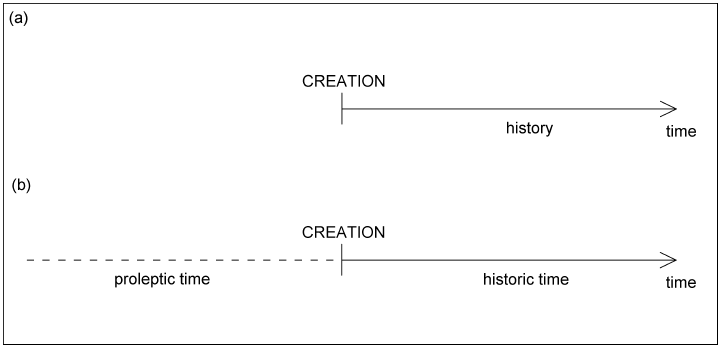 |
It is clear enough that "historic time" had everything to do with real history in Scaliger's mind. Scaliger could easily enough have chosen to label post-Creation time "Mosaic time" or "Hebraic time" or even "Biblical time" if politics or pedantics had motivated his invention of proleptic time. But his choice of "historic time" shows he meant to deliberately distinguish the character of these two types of time on the basis of their historical reality. While the whole character of "historic time" is solid historical reality; the whole character of "proleptic time" is intangible mathematical abstraction.
If it could have been demonstrated to Scaliger that the secular and sacred chronologies he had derived were sufficiently accurate to confidently support the conclusion that the earliest dynasties of Egypt dated earlier than Creation (in actual fact, data which have only come available since Scaliger's time have shown both Scaliger's chronology of Egypt and his chronology of the Bible to be significantly inaccurate, as he was obviously aware was possible) it seems clear enough that he would have judged the earliest dynasties of Egypt—those which fell in proleptic time—not to be real history, no matter how jolting such a conclusion may have appeared to his contemporaries.
It seems proper and fitting to me, in honor of Scaliger, to retain his term "proleptic time" to designate time taken before Creation, in a purely mathematical sense, as Scaliger intended (Figure 1). We stipulate, by the use of this term, that we are not merely referencing another era of real time; we mean fully to convey by this term imaginary time. Proleptic time is the mathematical projection of real historic time back behind Creation. Real historic time only begins at Creation, as the "In the beginning God created" of Genesis 1:1 teaches.
Virtual history
We need one other term in addition to proleptic time. We need a term to designate that sort of "history" which results from effects whose apparent causes were never really operative—the sort of "history" which "took place" in proleptic time, for example.
I suggest we avoid the term "proleptic history". (It appears that Scaliger never used this term.) It would mean "history taken before Creation". While it is clear enough how time might be extended, in a mathematical sense, back behind Creation, it is not at all clear how to extend history mathematically.
I suggest adoption of the term "virtual history".
A "virtual focus" in optics, is a point from which light rays seem to emanate when in fact no light emanates from that point at all (Figure 2). A "virtual image" in optics is an image made up of virtual foci. Light rays appear to emanate from all points of a virtual image, but in actual fact no light emanates from the virtual image at all. When you look at yourself in a mirror you are looking at a virtual image of yourself. Light rays appear to emanate from the other "you" in the mirror, which is why you see "yourself" in there. But in actual fact the light rays which are entering your eyes have emanated from the real you and have merely bounced off the mirror. What you see in the mirror looks real enough—so real, in fact, that it is easy to imagine a whole other world in there, as children frequently do. But the world one sees behind the silvered surface of the mirror is not real at all. There is, in reality, no other "you" behind the mirror looking out at you. Behind the mirror is only solid wall.
Figure 2: Illustrations of virtual foci. (a) Light rays from a point source of light in front of a mirror are reflected by the mirror with the result that they appear to emanate from a virtual focus behind the mirror. (b) Parallel light rays passing through a diverging lens from the left are refracted outward by it on the right with the result that they appear to emanate from a virtual focus to the left of the lens.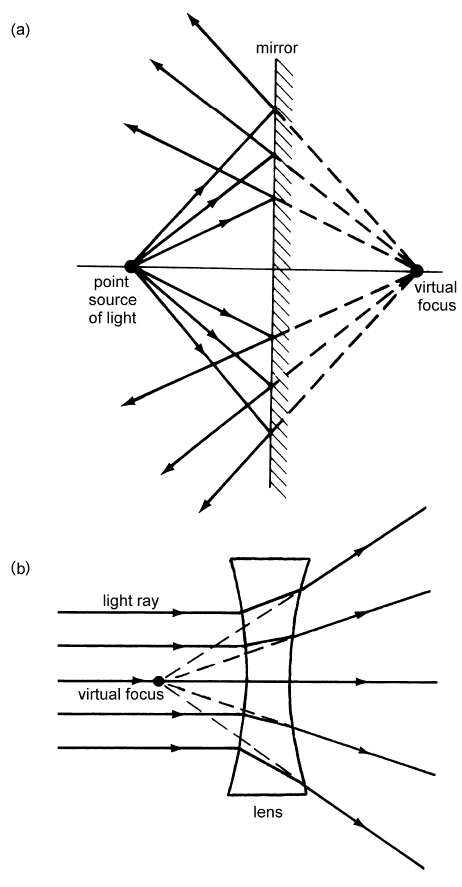 |
Real history is that from which time emanates. Virtual history is that from which time appears to emanate when in fact time does not emanate from it at all.
Principle 1
That is what I mean by the term "virtual history". Now I want to show that virtual history is not just an imaginary concept, invented for the purpose of saving the Bible from some embarrassing physical data from remote antiquity.
Feeding of the five thousand
The Gospel of Mark records this snatch of history:[13]
And He [Jesus] took the five loaves and the two fish, and looking up toward heaven, He blessed the food and broke the loaves, and He kept giving them to the disciples to set before them; and He divided up the two fish among them all. And they all ate and were satisfied. And they picked up twelve full baskets of the broken pieces, and also of the fish. And there were five thousand men who ate the loaves.
Let us travel back in history in an imaginary time machine to have a good look at those twelve baskets of leftovers. We are aware that a much greater mass of bread and fish has been collected up after the meal than was present in the crowd before the meal. We know that Jesus has done a miracle, somehow creating additional bread and fish from the original, small lunch. We are interested to see what newly created bread and fish look like.
Now I hope you will have no trouble agreeing with me, in this thought experiment, that the newly created bread and fish look very much like the original bread and fish. Indeed, it would be fascinating to study whether the two are distinguishable in any respect at all. But it is not necessary to delve into these physical data that deeply for the present purpose, and I do want to keep this simple.
I am sure you will agree with me at least that all these fragments of bread and fish look like they have been cooked—there is no raw fish or raw bread dough here in these baskets. Let me work from this assumed point of agreement.
Was this newly created bread and fish, which looks cooked, ever, in fact, cooked? Well, no; we know that it wasn't. We know that, in actual historical fact, it was simply created in this cooked state.
You see immediately, then, that these fragments of bread and fish have a virtual history. To say they look like they have been cooked is to say they give evidence of having been subjected to an elevated temperature at some point in the past. But we know, in point of historical fact, that they were not ever subjected to an elevated temperature at all. They were simply created this way.
Thus we see that virtual history is not unique to proleptic time. Virtual history seems to be a general artifact resident within the physical substance produced by creation-type miracles. If we cast our vision backwards through the miracle of the feeding of the five thousand on the basis of the physical substance (i.e., bread and fish) produced by that miracle we do not see real history. We see a virtual history.
I have made this point on the surficial observation that both the bread and fish appear to have been cooked. But I suggest the virtual history of these fragments goes much deeper than that. I suggest that if one probes the newly created fish scientifically, for example, they will discover bones, and muscle, and veins, and biological cells, and even DNA with a whole genetic blueprint of the fish encoded within it. The Bible, after all, is quite clear that it was fish which Jesus created, not a soybean substitute, and fish entails all of these things. And all of this speaks of an elaborate "history". But the "history" it speaks of is one which this newly created fish flesh never actually had. The more versed one is in modern biology the more readily apparent the virtual history inherent within this newly created fish flesh becomes, and the more elaborate it is seen to have necessarily been. But it is unnecessary to press this point further here.
Water into wine
The miracle of the creation of wine from water which is recorded in John 2:1–11 provides another example of virtual history. If we study the wine which Jesus created from water on that occasion we find that it is of highest quality. Note the headwaiter's appraisal, "you have kept the good wine until now". One does not get "good wine" by just squeezing a few grapes. To get "good wine" there needs to be a protracted aging process. The fact that the wine Jesus created was "good wine" means that this wine gave the impression of having been through a lengthy aging process. If you study this wine, as the headwaiter has done with his eyes, nose, and tongue, or however more sophisticated scientific apparatus you may please, I venture to suggest that you will come away with precisely this same impression. It is "good wine" after all, and such is the nature of good wine.
But we know this wine never experienced a lengthy aging process; we know it was created only moments before. The newly created wine, we must conclude, has a virtual history quite apart from its real history.
Man born blind
Here is one more example. The Gospel of John, chapter 9, records another miracle. Here Jesus gave sight to a man who had been born blind. The thing about being born blind is that there is a great deal of learning connected with vision which normally takes place in the earliest months of life after birth, and which seems extremely difficult if not impossible to learn subsequent to that age. For example, when we first open our eyes after birth our brains are confronted with two images of the world, one from each eye. Because our two eyes are not in identically the same place, these two images are not identical. The problem of putting these two different images together into one composite, three-dimensional picture of reality must be worked out by the brain (i.e., learned) very early on, or it is unlikely ever to be learned at all.
Jesus worked a miracle, and this man who had been born blind could see. If we imagine studying this man moments after this miracle, seeking to know what newly imparted sight is like, we do not find him crossing and uncrossing his eyes as he vainly tries to learn how to keep those two images lined up, and as he struggles to unite them into a single composite image. He seems to already know all the things necessary to see. But such knowledge implies a learning experience—a learning experience during infancy. You see then that the physical data—the condition of the man's eyes, optic nerves, and most especially the arrangement of neural connections within the visual regions of his brain, give the impression of one who has been able to see since birth; they fail entirely to show a man born blind who had remained blind until moments before when Someone put clay on his eyes and told him to go wash in the pool of Siloam. This was a creation-type miracle in which sight was created. The physical substance affected by this creation-type miracle—the restored eyes, optic nerves, and brain cells—exhibit a virtual history distinct from their true history.
Obviously, virtual history is not unique to proleptic time. It seems, rather, to be a general feature of creation-type miracles. Virtual history is what one "sees" looking back through the "lens" (or into the "mirror") called "creation-type supernatural event".
I find, then, this fundamental principle:
Principle 1 Virtual history is an intrinsic artifact of creation-type miracles.
Essentials of Virtual Histories
Notice that the virtual histories in the foregoing examples look real enough. But they are not, in actual historical fact, real at all. We find from these examples that it is possible to trace the emanations of time back from the present towards a historical creation-type supernatural event, just as it is possible to trace rays of light back from our eyes toward a mirror. When we do so, we now realize, we are bound to see something. But just as surely as reality vanishes as soon as we extrapolate those rays back behind the mirror's surface, so reality vanishes when we extrapolate those emanations of time back behind the miracle.
We have not discussed how to predict what a virtual history will look like in any given instance, or even whether it is possible to predict such a thing. But at this point such questions are unimportant. At the present stage the only really important things to observe are that: 1. virtual histories exist, 2. they look real, but 3. they do not correspond to real history at all, and 4. creation-type miracles inevitably give rise to some sort of virtual history.
Virtual Histories Applied
Our new solution to the central conundrum is now, I hope, beginning to look less strange. The Bible teaches us—if we are willing to accept its teaching—that supernatural events do happen in real life, and we find that at least one category of supernatural events, the creation-type category, gives rise to virtual histories. The Creation itself was most certainly a creation-type of supernatural event. We are no longer surprised, then, to find a virtual history for proleptic time within the physical data emanating from the creation period.
The apparent incongruity of Grand Fact 1 and Grand Fact 2 is now easily understood. Both of these Grand Facts are facts, but Grand Fact 1 is a statement about real history, while Grand Fact 2 is a statement about virtual history in proleptic time. Grand Fact 1 is the historical truth; Grand Fact 2 is an artifact of the supernatural character of the origin of the world.
Notice that the three creation-type miracles given as examples above each exhibit seemingly contradictory "Grand Facts" of their own. For the feeding of the five thousand Grand Fact 1 is that the multiplied fish and bread have come into existence only moments before. Grand Fact 2 is that considerable evidence exists within the fish and bread fragments themselves that they were cooked some hours previously. For the water to wine miracle Grand Fact 1 is that the wine has only moments before been created out of water. Grand Fact 2 is that considerable evidence exists within the wine itself that it has undergone a protracted aging process. For the man born blind Grand Fact 1 is that this man was born blind and has only moments before begun to see for the first time in his life. Grand Fact 2 is that considerable evidence exists within the man's visual apparatus that he has been able to see all his life.
In all of these cases these Grand Facts are facts. It is utterly futile to try to deny either of them in any of these instances. Their reconciliation rests in the recognition of the existence and nature of virtual histories. In each case Grand Fact 1 is a statement about real history while Grand Fact 2 is a statement about virtual history. Grand Fact 1 is the historical truth while Grand Fact 2 is an artifact of the creation-type miracle in each instance.
Finally, while it seemed strange to conclude that Grand Fact 2 only became operative after Grand Fact 1, as we deduced above, we now see that there is nothing strange about this at all. The same is true in all three examples of creation-type miracles given above. For the miracle of the feeding of the five thousand the evidence that the fish and bread have been cooked hours previously only arises after the fish and bread have been created. For the miracle of the changing of the water to wine the evidence that the wine has been through a protracted aging process only arises after the wine has been created. For the miracle of giving sight to the man born blind the evidence that he has been able to see all his life only arises after he has been given his sight. It is now obvious enough that this is how it must be. We can now see that this results from the simple fact that virtual histories cannot arise before the supernatural events have occurred which give rise to them.
Unification Achieved
Strictly speaking we are done. Recall that we set out, some months ago, to unify sacred and secular chronologies in the pre-Flood period (i.e., prior to about 3500 B.C.). We observed that there is no apparent point of tension between Biblical and secular chronologies of earth history in the pre-Flood period until one gets back to the creation of Adam. Thus, unification exists back to Creation Week. At that point, however, the central conundrum appears: secular chronology finds mankind in existence many thousands of years before the Biblical date of the creation of Adam. Unification of pre-Flood chronology required that a solution to the central conundrum be found.
A solution to the central conundrum has now been found. The Bible informs us that the creation of Adam is a part of a brief period of history during which the whole of physical reality was created and brought to its present form. This brief period of history is fully characterized by creation-type miracles. Principle 1 informs us that virtual history is an intrinsic artifact of creation-type miracles. Thus, Principle 1 informs us that we will find some sort of virtual history of the world within the physical data of creation as we examine it today. This virtual history will appear to extend back before Adam and back before Creation into the timeless, historyless void of pre-Creation. Thus a historical and chronological conflict between sacred and secular in connection with Adam's creation is anticipated. The central conundrum is merely this anticipated conflict.
We now understand that this conflict is apparent only. We now see that it is entirely permissable, and no real conflict at all, for secular chronology to find mankind in existence many thousands of years before the Biblical date of the creation of Adam, because secular chronology prior to Creation is a chronology of a virtual history in proleptic time only. We now understand that the secular chronologists have been telling us what they see as they peer back through the creation-type miracles responsible for the existence and character of the cosmos we find ourselves in today. Principle 1 tells us that what they will see in this instance is virtual history only. Up until now they have not understood this. They have confused virtual history with true history; they have mistaken the virtual images in the mirror for reality. And, I have no doubt, many will continue to insist, when these things have been pointed out to them, that the virtual history they study is not virtual at all—that it is brute, palpable, reality itself. But the Christian aught not to do so. The one who truly believes the Bible should not suppose that, while the Bible doesn't mention it, Jesus and the disciples must in actual fact have busied themselves cooking all those loaves and fish they fed to the multitude that day—and not only that but cleaning all those fish too, and catching them all, and kneading all that bread dough, and mixing the ingredients for it, and grinding the sacks of grain to make the flour for it, and… The one who truly believes the Bible will rest in what the Bible reveals to be the intrinsic nature of creation-type miracles.
And once they have done so, they will find that the chimera of conflict between Biblical and secular chronologies of cosmic history has vanished.
Said simply, logically accurate thinking within a Biblical framework predicts that an apparent conflict between secular and sacred chronologies of the world will be found prior to the creation period, at the very origin of Biblical chronology. This apparent conflict has now been identified. And what that means is that we are done; unification of sacred and secular chronologies of cosmic history has been achieved.
Curse, Not Creation
Though we are finished, I must not stop at this point, of course. While unification has been achieved, much remains which must yet be said.
I must, for example, immediately clarify that I am not saying that the virtual history in proleptic time which appears today is an artifact of Creation itself. Principle 1 leads us to expect that Creation did have a virtual history. But that virtual history is veiled to our eyes at present. It is veiled because between Creation and the present there sits another creation-type miracle called the Curse, resulting from the Fall. When we look backwards in time we necessarily peer through the lens of the Curse, not the lens of Creation.
The Bible is clear that the whole world was changed as a result of the sin of Adam. The whole character of reality was somehow changed by the Curse, from pleasure and meaning and fulfillment to pain and emptiness and futility. Romans 8:20, in speaking of these things, says "for the creation was subjected to futility, not of its own will, but because of Him who subjected it" (NASB). The act of subjecting the universe to futility necessarily involved creation-type miracles. We are given glimpses of this immediately in the account of the Fall and the Curse (Genesis 3). There, for example, we see the restructuring of man's work experience. Now the ground, which had yielded "every tree that is pleasing to the sight and good for food", brings forth "thorns and thistles" instead. There also, for example, we see the restructuring of woman's child-birth experience, with pain and ambivalence the consequence. As in the case of the man born blind this obviously involved some very basic physiological restructuring.
The universal consequences of the Fall and the Curse are elaborated in the New Testament, especially in contrast to the future state when God will intervene once more to judge and to restore all things. For example, in Romans 8:21–22 we read "that the creation itself also will be set free from its slavery to corruption into the freedom of the glory of the children of God. For we know that the whole creation groans and suffers the pains of childbirth together until now." This figure of speech, "suffers the pains of childbirth", appears as a direct allusion to God's pronouncement of judgment upon Eve at the Curse mentioned above, "I will greatly multiply your pain in childbirth, in pain you shall bring forth children" (Genesis 3:16; NASB). Thus, by this metaphor, Paul shows that the Curse brought about a restructuring not just of the basic physiology of Eve, but indeed of the basic physics of the whole creation.
We must regard the Curse, then, as a creation-type miracle operative upon the entire cosmos. And in consequence of this, the virtual history of proleptic time which we now see must be regarded as an artifact of the Curse, not of Creation.
Historical Reconstruction
I find, then, the following reconstruction of the history of the creation period (Figure 3).
Figure 3: Time-line showing a reconstruction of the history of the creation period. |
The world was supernaturally brought into existence out of nothing by God 5176±26 B.C. and fashioned and furnished by Him through a sequence of miracles over the course of six ordinary days, culminating with the creation of Adam on Day 6. The initially created world was not of the same character as the world we live in today. Sometime subsequent to Creation Week Adam and Eve ate of the forbidden fruit of the tree of the knowledge of good and evil. The Bible does not specify how long after, but one gets the impression of days, weeks, or possibly months. This was the Fall. The result was the Curse, with the subjecting of the whole creation to futility, as we find it to be in actual experience today. The virtual history of proleptic time we see today—including evidences of pre-Adamic man, dinosaurs, exploding stars, concentrations of radioisotopes in rocks, and all the rest—had its origin at that time.
Now I hope you will agree with me that the sequence of events and the timing of them in this reconstruction are certainly not radical departures from traditional thinking. If you research the matter you will find that they are, in fact, pretty much in line with what the early church fathers, for example, believed Genesis meant to communicate.
This is quite remarkable. Having applied all that modern science has to offer by way of technical and factual advancement in the field of chronology we find ourselves, on this whole question of the chronology of earth history, back where Christians were two thousand years ago. All that has been done, really, in delving into this ninth conceptually possible solution of the central conundrum, is to show that the plain, simple, thousands-of-years-only chronology of the past, which the Bible has been communicating to its readers from very ancient times, is every bit as functional in our scientifically advanced and technologically sophisticated world today as it was when it was first written thousands of years ago.
Monogenetic Headship?
I can find only one point where this present solution seems to differ from traditional expectations. The difference is interpretive, not chronological, but it is a difference just the same, and therefore deserving of special scrutiny.
This solution finds other humans besides Adam and Eve in existence at least from the time of the Curse on. This follows logically from the fact that archaeology reveals human remains and artifacts before, during, and after the time of the creation of Adam, and on continuously from there. What one sees in the archaeological record before the Curse we know to be virtual history only, but from the Curse on one is dealing with real history. Thus archaeology reveals other human populations in existence from the time of the Curse on. I have not had opportunity to go back and check traditional thinking on this yet, but certainly it is widespread belief today that the Bible teaches that all of humanity has descended genetically from Adam and Eve.
More important than traditional beliefs on this matter, of course, is what the Bible has to say about it. Having researched this question I must report that I can find, in fact, no solid Biblical footing for the doctrine that Adam and Eve are the genetic heads of humanity. Meanwhile there seem to be several indications embedded within Genesis itself that Adam and Eve were not the only humans to emerge from the creation period. (By "creation period" I mean the Creation, Fall, and Curse inclusive).
Romans 5:12
The Bible definitely does teach a certain unity of mankind under Adam. For example, "Therefore, just as through one man sin entered into the world, and death through sin, and so death spread to all men, because all sinned" (Romans 5:12). But Adam appears only as a historic representative of mankind in such cases. Genetic headship is never specified.
1 Corinthians 15:39
1 Corinthians 15:39 says, "All flesh is not the same flesh, but there is one flesh of men, and another flesh of beasts, and another flesh of birds, and another of fish". A certain unity of mankind is found here as well, but it is not a monogenetic unity either. To read this as a statement of the monogenetic origin of mankind would also demand we accept a monogenetic origin of all birds, and another monogenetic origin of all fish. But such an interpretation seems forbidden not only by the enormous number of species of birds and fishes alive today, but also by what we are explicitly told about their creation in Genesis 1:20. Specifically (NASB), "Then God said, 'Let the waters teem with swarms of living creatures, and let birds fly above the earth in the open expanse of the heavens'." To instantaneously "teem with swarms" seems to explicitly require a polygenetic origin of the fishes at least.
Acts 17:26
A unity of mankind is again seen in Acts 17:26, "and He made from one [or possibly, 'one blood'], every nation of mankind to live on all the face of the earth". This appears to be the closest one ever gets to explicit support for the monogenetic origin of mankind in the New Testament. But it too falls short of this mark. If Paul had said, 'He made from one individual' or 'He made from one man, Adam…' the case would be clearly closed. But Paul did not say this, and it is difficult to suppose he ever meant even to imply this.
This passage is taken from Paul's address to the men of Athens. In context, Paul is arguing against their polytheism and pointing them to the one true God through repentance and faith in Christ Jesus. To have introduced the premise of the genetic unity of mankind in Adam into the argument to these Athenians would have served no useful purpose and would only have clouded his message. These listeners were pagans unfamiliar with Adam. The origins of the different stocks of mankind would have been an interesting open question to them. But to get their thinking off into that issue would be to detract from the central issue and the whole purpose of Paul's presentation, which was to show them their individual need of Christ.
In context Paul is arguing, not the genetic unity of mankind as progeny of Adam, but the universal need of mankind for a Savior. I suggest that the unity of mankind which is alluded to here is the same sort as is found in the 1 Corinthians 15:39 passage just discussed above. This is the idea that, though fish come in many different varieties, there is a basic unity among fishes which, for example, sets them completely apart from birds. Though greatly varied, they exhibit a deep unity. They seem, while sporting many unique options and accessories, to nonetheless have all been fashioned from a single basic blueprint. Paul is saying that while there is much variation in physical appearance and cultural behavior among mankind, the fact is that all men are fashioned by God from a single basic blueprint, with the logical inference that men of all nationalities, whether Jews or Greeks, have the same need of a Savior.
Genesis 3:20
One other passage which might be felt to bear explicitly on this matter is Genesis 3:20. It says (NASB), "Now the man called his wife's name Eve, because she was the mother of all the living". This could be interpreted as an explicit statement of the genetic motherhood of Eve (and hence also the genetic fatherhood of Adam) over all mankind.
I find such an interpretation improbable, as I have previously pointed out in another context.[14] The difficulty with this interpretation is that it renders this verse anachronistic. At this point in the narrative, just subsequent to the Curse, Eve was, in point of historical fact, the mother of no one. To interpret this verse as a statement of Eve's universal motherhood over all mankind gives the phrase "because she was the mother of all the living" the character of a scribal gloss, written into the margin of the text as an explanatory note to other scribes while looking back millennia after the events described by the narrative itself had transpired, rather than the character of part of the original narrative. To avoid this apparent anachronism requires the text to say,"because she was to become the mother of all who would live". But the text does not say this. It says she was then, at that point in the narrative, the mother of all who were then, at that point, living.
My training is in physical science, not textual criticism. I am, therefore, not qualified to pass any final judgment on this textual question. So I will simply observe that interpretation of this verse as guaranteeing the monogenetic headship of Adam and Eve seems precarious because: 1. of the apparent anachronism generated in doing so, 2. of the lack of support for such an interpretation elsewhere in Scripture, and 3. of other Scripture passages which seem to show the opposite. It is to this last point that I now turn.
Genesis 4:12–17
There are at least two indications in the Genesis narrative that other stocks of humanity existed besides just Adam and Eve following the Curse. The first is seen with God's punishment of Cain for the murder of Abel, recorded in Genesis 4:12–17.
Cain had been a sedentary farmer, apparently somewhere within the Eden region, though external to the Garden of Eden, as I have previously discussed.[15]. This lifestyle was now forbidden to him: "When you cultivate the ground it shall no longer yield its strength to you". From this point on he was condemned to live as "a vagrant and a wanderer on the earth". This, evidently, meant living outside the Eden region because Cain complained, "from Thy face I shall be hidden" and verse 16 says "Then Cain went out from the presence of the Lord and settled in the land of Nod, east of Eden." Thus God's judgment entailed disruption of Cain's mode and location of living.
What is interesting in the present context is Cain's response to God. He argues that God's punishment is too severe, that it amounts to being condemned to death. He says, "whoever finds me will kill me". Taken at face value this seems to imply that there were other people at that time living outside the Eden region, hostile to any who might venture into their territory.
This interpretation can be avoided by the assumption that Cain was not referring to other people already outside the Eden region, but to future descendants of Adam who would spread from the Eden region and take vengeance on Cain once they had found him. But this does not fit the context very well. Note that God does not respond to Cain's complaint by pointing out that there were a whole seven continents out there, and countless islands, all uninhabited and waiting to be explored, so Cain would have no trouble keeping ahead of any makeshift posse. God treats the threat to Cain's life from other human beings altogether seriously, going so far as to give him a supernatural sign for his protection. Why should God respond to Cain's complaint in this extraordinary way if all the world outside the Eden region was at that time completely unpopulated?
Furthermore, if Cain was worried merely about vengeance from his relatives, then his complaint that God's judgment was too severe is very curious. If vengeance on Cain by his relatives was Cain's concern, then it was obviously a much bigger concern if he stayed in the Eden region, where they all lived at that time, than if he left. In that case he would be better off to get out of the Eden region and head for the hills. He should not complain "I shall be a vagrant and a wanderer on the earth, and it will come about that whoever finds me will kill me"; he should rather say, "I quite agree; I really need to get out of here, and the sooner I leave and the further I go the better."
Genesis 6:1–4
Even more forceful to me is the second indication from Genesis that other stocks of humanity existed besides just Adam and Eve following the initial creation period. This indication arises in connection with the "sons of God" found in Genesis 6:1–4. Here we find (NASB):
Now it came about, when men began to multiply on the face of the land, and daughters were born to them, that the sons of God saw that the daughters of men were beautiful; and they took wives for themselves, whomever they chose. … The Nephilim were on the earth in those days, and also afterward, when the sons of God came in to the daughters of men, and they bore children to them. Those were the mighty men who were of old, men of renown.
This passage raises the question of who the "sons of God" were. Two principal theories can be found for this. One is that they were descendents of the supposedly godly line of Seth, chronicled in Genesis 5, who married women from the supposedly ungodly line of Cain detailed in Genesis 4. The other is that they were angels who left the angelic realm and came down to earth to cohabit with the daughters of men. While arguments can be marshaled from Scripture in defense of both theories, the fact that two principal theories continue to exist despite many years of discussion on the matter shows that neither is really satisfactory.
Study of the use of the term "son of God" in the Bible reveals that the term means one who has come directly (first generation) from God by any means. Thus the angels, including the fallen angels and their leader, Satan, are all sons of God by direct creation.[16] Those who have been born again are spiritual sons of God by virtue of the new creation.[17] Jesus is "the only begotten son of God".[18] That is, He is the only one to have come directly from God by means of birth through a woman. And, most importantly for the present question, the Bible calls Adam a son of God—this again by virtue of direct creation.[19]
This Biblical meaning of the term shows clearly that if any other humans had been created subsequent to the creation of Adam, they would also have been sons of God just as Adam was. This, I suggest, is the simple meaning of the reference to sons of God in Genesis 6. The text presumes the reader is aware that Adam and Eve were not the only created humans, and it includes these others in the narrative without apology or ado.
What the text seems to be communicating in this passage is that the crossing of Adam's line with the genetic lines represented by these other created men resulted in hybrid vigor in the children. This, I suggest, is the simple explanation of the "mighty men" and "men of renown" which resulted from these marriages. By way of contrast, it is very difficult to see why the crossing of Cain's and Seth's lines should yield "mighty men" and "men of renown" as a unique, noteworthy result; and very nearly impossible to see how the imagined physical interbreeding of angels and humans could give rise to any offspring at all, let alone offspring one might call "men". Notice that it is an experimental fact that when one manages to overcome the significant barriers to the interbreeding of two species even as closely similar as the lion and the tiger, the resulting offspring are neither lions nor tigers.
The monogenetic headship of Adam and Eve over all mankind is deeply embedded doctrine today. It therefore seems surprising to find this doctrine challenged by this new chronological unification. But when one actually appraises the Biblical data bearing on this question one finds that perhaps the plain sense of the archaeological data is not so surprising after all. I am reminded that it was once also deeply embedded doctrine that the orbits of the planets should be perfect circles, that the surface of the moon should be a perfectly smooth sphere, and that all heavenly bodies should orbit the earth.
Philip Henry Gosse
This new unification raises many other questions—as is normal for new paradigms. I do not yet have answers for them all, of course. But I know of no question which this unification raises which poses any serious challenge to its validity.
The closest theory I have seen to this present unification is one originally propounded by Philip Henry Gosse in his book, Omphalos, published in 1857.[20] Gosse is very clear that he regarded Creation as real and as an absolute starting point, before which there was neither history nor time. Gosse was a zoologist of considerable stature in his day, and the arguments of his book draw heavily from his careful observations in that field. He was keenly aware, from his studies, that a newly created organism would necessarily bear many evidences of having existed prior to its creation. This led Gosse to differentiate between prochronic developments, ("because time was not an element in them"), and diachronic developments ("as occurring during time") in newly created organisms.[21] Prochronic and diachronic developments are simply expressions of virtual and real history specific to the biological realm.
Gosse also separated between ideal time and actual time. These are parallel to Scaliger's proleptic time and historical time, with the distinction that Gosse, not being a chronologist, left the question of the actual date of Creation open. I think it would be quite inaccurate to suggest Gosse left this question open out of any personal ambivalence regarding it. Every indication is that he personally held to the plain sense of Biblical chronology and that he believed that Creation had happened roughly six thousand years ago, as was common for devout individuals of that day tutored in Ussher's chronology. But he was not trying to prove that one must accept a six thousand year real history of the world—an effort which would have taken him very wide of his field. He was trying to show that if one accepts the fact of Creation, one automatically gets "prochronisms"—which he demonstrated with an exhaustive thoroughness from his field. Gosse hoped to make the point, by analogy with his observations from zoology, that it is a logical error to conclude the Biblical date of Creation falsified by physical data appearing to show a great antiquity for the world.
I wish to be distinctly understood that I am not proving the exact or approximate antiquity of the globe we inhabit. I am not attempting to show that it has existed for no more than six thousand years. I wish this to be distinctly stated, because I am sure I shall meet with many opponents unfair enough, or illogical enough, to misrepresent or misunderstand my argument, and sound the trumpet of victory, because I cannot demonstrate that. All I set myself to do, is to invalidate the testimony of the witness relied on for the indefinitely remote antiquity [of the world]; to show that in a very large and important field of nature [i.e., zoology], evidence exactly analogous to that relied on [for demonstrating a remote antiquity of the world] would inevitably lead to a false conclusion,…[22]
I hope I have been perfectly clear in my presentation that I do not leave the date of Creation open. While Gosse was not a chronologist, I am. While Gosse only aspired to defend Biblical chronology from an overhasty and undeserved condemnation which had arisen as a side effect of secular chronology, I aspire to unify Biblical and secular chronologies into a single, harmonious whole. While a lack of chronological precision and definition was not detrimental to Gosse's purpose, it is inimical to mine. The date of Creation can be determined using the normal tools and methods of the chronologist's discipline just as surely as the date of any other historical event can be determined. The dividing line between proleptic time and real time is the Creation event recorded in the Bible. The Bible provides a chronology of history back to and including that event. According to modern Biblical chronology Creation happened 5176±26 B.C. Prior to 5176±26 B.C. is proleptic time only. From 5176±26 B.C. to the present is real time. Proleptic time exhibits virtual history only. Real history begins with Creation at 5176±26 B.C.
Creation versus Curse
Gosse and I differ on one other point as well. Omphalos leaves its reader with the impression that the virtual history of proleptic time we see today is a direct consequence of Creation itself. I have tried to be careful to show that this is not the case. To be logically consistent one must attach this virtual history not to the Creation but to the Fall and the Curse. This is an important distinction with a number of significant consequences. It seems important to highlight a single theological consequence here.
To assign the virtual history in proleptic time which we now see to the Creation implies, for example, that God created most of the fossils of the earth which we see today sometime during Creation Week. Since all the work of Creation Week was seen to be "very good" by God[23] this would mean that the fossils were also "very good". But this immediately presents a theological difficulty. The main thing fossils speak of is death. Fossils result from death, and frequently they show unpleasant deaths. For example, fossils have been found of fish with other fish in their stomachs. Could all of this have been created by God during Creation Week, and all deemed "very good"?
But it is not just fish we must contend with here. There are also human remains, recovered from deliberate burials, also found within the virtual history of proleptic time. Indeed, that is part of the very evidence which led us to identify virtual history and proleptic time in the first place. We saw above that this sort of evidence could not have existed prior to the creation of Adam, because the Bible teaches us that Adam was the first man ever to have existed. But even if we suppose that this evidence was created by God late on Day Six, after Adam had been created, then it still would fall under God's "very good" assessment. Could evidence of human death, even of young people and infants, be a feature of Creation's virtual history and all of Creation still be deemed "very good" by God?
The whole character of the virtual history of proleptic time which we see today is one of death, and horror, and pain, and futility. We learn from the Bible that these are not native to Creation; rather they are the consequences of sin.[24] It does not seem theologically possible that even virtual history could have displayed the character it does today prior to the entrance of sin into the world at the Fall. Death, and horror, and pain, and futility are the fruits of Satan's work, not God's work. Yet if one assigns the virtual history of proleptic time which we now see to Creation, one necessarily implies that these are fruits of God's work.
Obviously, this is an important distinction. Clearly, it is important that Principle 1 be applied in a logically consistent fashion. Since virtual histories result from all creation-type miracles, the virtual history of proleptic time which we see today is necessarily an artifact of the Fall and the Curse, not of Creation. In this matter Gosse's thesis differs substantially from mine.
Gosse's theory has been frequently criticized for its objectionable theological implications. I suppose it is overly sanguine to hope I shall be entirely spared condemnation for Gosse's oversight by critics of my thesis. But thoughtful readers will see that there is a substantial difference between our two theories, so that the old theological arguments against Gosse's thesis cannot logically be trotted out against mine. This unification of sacred and secular chronologies is not just another presentation of the "Creation with appearance of age" idea. It is, rather, a new idea which I should label, if anything, "Curse with investiture of futility". Let it not be libeled that I am promoting the concept that God put fossils in the rocks to fool fools. Please notice that the Fall was the Serpent's victory and the Curse his spoil, not God's. The only one in the business of fooling fools is the Serpent.
Implications
There are three implications of this chronological unification which seem to me to warrant explicit mention before I bring this article to a close.
The first is that efforts to prove a seven thousand year old earth and cosmos from the physical data are now seen to be seriously inappropriate. They amount to trying to prove that the fish Jesus fed to the five thousand were born, grown, caught, cleaned, and cooked all in the few moments before the meal began. Will the Master be honored by disciples so engaged?
The second is that efforts to stretch Creation Week out over long geologic ages (e.g., day-age theories) are also seen to be seriously inappropriate. They are, in final logical analysis, simply a denial of supernatural Creation. They amount to trying to prove that the fish Jesus fed to the five thousand were born, grown, caught, cleaned, and cooked over the natural time span common to all fish that have ever been born, grown, caught, cleaned, and cooked, in full agreement with the physical data from the fish fragments. Real creation-type miracles, we have seen, have a virtual history. If the geologic ages are not the virtual history resulting from the creation period, then what is the virtual history from that period? Failure to find a virtual history resulting from the creation period is just another way of saying that no creation-type miracle occurred in connection with Creation. And that is just a way of saying that Creation was a natural phenomenon rather than a supernatural one. Will the Creator—He who "spoke, and it was done"[25]—be honored by such a recasting of His work of Creation?
Third and final, Christians need to stop squandering time and energy deriding evolution. The Bible says evolution didn't happen, not that it couldn't happen. The Bible says "In the beginning God created the heavens and the earth"[26], not "In the beginning God evolved the heavens and the earth". So the fact that we got here by supernatural Creation is plain and settled. But evolution is still a perfectly legitimate scientific hypothesis of virtual history in proleptic time. Now please note that I did not say amoeba to man evolution is what virtual history shows. In point of fact I seriously doubt that amoeba to man evolution is what virtual history actually shows. I am trying to convey that the truly fascinating question now is what it is that virtual history really does show, in sharp contrast to the purely negative exercise of trying to prove that the data of virtual history do not show evolution.
The linchpin of evolution has been the belief that Biblical chronology and Biblical history have been falsified. That is, the linchpin of evolution has been the belief that supernatural Creation has been shown to be false. This has seemed to leave naturalism in possession of the entire playing field. As long as naturalism has had possession of the entire field, evolution has necessarily been the only game allowed. But we now understand that Biblical chronology and Biblical history have not been falsified. The linchpin of evolution has, in fact (whether any evolutionists ever admit it or not), been pulled. That being the case, Christians need to get involved in the exploration of virtual history in a positive way, formulating and testing other hypotheses of organic relationships in virtual history. They are the right ones to do this work; they are the ones whose eyes are now wide open.
Real history, the Bible informs us, is a mixture of natural and supernatural events. It would, therefore, not be surprising to find that virtual history was also such a mixture. Perhaps this is the true lesson to be learned from the systematic absence of transitional forms between fossil kinds. Perhaps this is the true lesson to be learned from the complete failure of modern science to demonstrate a naturalistic origin of the living cell. The field is wide open. It is time to stop the negative exercise of beating up on evolution. It is time for the positive exercise of finding out the truth about virtual history to begin.
Conclusion
Creation lies at the root of all of physical reality. It is, therefore, not possible, in any brief space, to introduce a theory for the unification of sacred and secular chronologies back into the dawn of Creation which covers all contingencies. Still, I hope that sufficient breadth has been achieved in these few pages to give an accurate impression of what this new unification looks like, the foundation upon which it stands, and some of the potential it seems at present to hold.
In closing it seems appropriate to simply recap the thread of the argument leading to this long-sought unification of sacred and secular chronologies in the pre-Flood period.
If one believes in creation-type miracles, one automatically believes in the existence of virtual histories, whether one knows it or not. Virtual histories are logical imperatives of creation-type miracles.
Thus, if one believes the world came into existence through supernatural Creation, as the Bible teaches, then they believe the whole cosmos has a virtual history.
To say the whole cosmos has a virtual history is to say the whole cosmos gives the appearance of having existed prior to Creation in proleptic time.
Therefore, belief in Biblical Creation logically carries with it a prediction that secular chronology and secular "history" will appear to extend back beyond the Biblical date of Creation (5176±26 B.C. according to modern analysis) into proleptic time.
Unification of sacred and secular chronologies is achieved by simply identifying modern secular chronology prior to the Biblical date of Creation with this predicted chronology of virtual history in proleptic time.
The Biblical Chronologist is a bimonthly subscription newsletter about Biblical chronology. It is written and edited by Gerald E. Aardsma, a Ph.D. scientist (nuclear physics) with special background in radioisotopic dating methods such as radiocarbon. The Biblical Chronologist has a threefold purpose: to encourage, enrich, and strengthen the faith of conservative Christians through instruction in Biblical chronology, to foster informed, up-to-date, scholarly research in this vital field within the conservative Christian community, and to communicate current developments and discoveries in Biblical chronology in an easily understood manner.
An introductory packet containing three sample issues and a subscription order form is available for $9.95 US regardless of destination address. Send check or money order in US funds and request the "Intro Pack."
The Biblical Chronologist (ISSN 1081-762X) is published six times a year by Aardsma Research & Publishing, 412 N Mulberry, Loda, IL 60948-9651. Copyright © 1999 by Aardsma Research & Publishing. Photocopying or reproduction strictly prohibited without written permission from the publisher. |
Footnotes
^ The previous four articles were: Gerald E. Aardsma, "Toward Unification of Pre-Flood Chronology," The Biblical Chronologist 4.4 (July/August 1998): 1–10; Gerald E. Aardsma, "Toward Unification of Pre-Flood Chronology: Part II," The Biblical Chronologist 4.5 (September/October 1998): 1–10; Gerald E. Aardsma, "Toward Unification of Pre-Flood Chronology: Part III," The Biblical Chronologist 4.6 (November/December 1998): 1–16; and Gerald E. Aardsma, "Toward Unification of Pre-Flood Chronology: Part IV," The Biblical Chronologist 5.1 (January/February 1999): 1–10.
^ Gerald E. Aardsma, A New Approach to the Chronology of Biblical History from Abraham to Samuel, 2nd ed. (Loda IL: Aardsma Research and Publishing, 1993); Gerald E. Aardsma, "Toward Unification of Pre-Flood Chronology," The Biblical Chronologist 4.4 (July/August 1998): 1–10.
^ Gerald E. Aardsma, "Toward Unification of Pre-Flood Chronology," The Biblical Chronologist 4.4 (July/August 1998): 10.
^ Gerald E. Aardsma, "Toward Unification of Pre-Flood Chronology: Part II," The Biblical Chronologist 4.5 (September/October 1998): 1–10.
^ Gerald E. Aardsma, "Toward Unification of Pre-Flood Chronology: Part II," The Biblical Chronologist 4.5 (September/October 1998): 1–10; Gerald E. Aardsma, "Toward Unification of Pre-Flood Chronology: Part III," The Biblical Chronologist 4.6 (September/October 1998): 1–16; Gerald E. Aardsma, "Toward Unification of Pre-Flood Chronology: Part IV," The Biblical Chronologist 5.1 (January/February 1999): 1–10.
^ Gerald E. Aardsma, "Toward Unification of Pre-Flood Chronology," The Biblical Chronologist 4.4 (July/August 1998): 3.
^ Gerald E. Aardsma, "Toward Unification of Pre-Flood Chronology: Part IV," The Biblical Chronologist 5.1 (January/February 1999): 1–10.
^ Gerald E. Aardsma, "Toward Unification of Pre-Flood Chronology: Part II," The Biblical Chronologist 4.5 (September/October 1998): 9.
^ Gerald E. Aardsma, "Toward Unification of Pre-Flood Chronology," The Biblical Chronologist 4.4 (July/August 1998): 8–10.
^ Anthony T. Grafton, "Joseph Scaliger and Historical Chronology: The Rise and Fall of a Discipline," History and Theory 14.2 (1975): 156–185.
^ Gerald E. Aardsma, "Toward Unification of Pre-Flood Chronology: Part III," The Biblical Chronologist 4.6 (November/December 1998): 1–16; Gerald E. Aardsma, "Toward Unification of Pre-Flood Chronology: Part IV," The Biblical Chronologist 5.1 (January/February 1999): 1–10.
^ Anthony T. Grafton, "Joseph Scaliger and Historical Chronology: The Rise and Fall of a Discipline," History and Theory 14.2 (1975): 173.
^ Mark 6:41–44; NASB.
^ Gerald E. Aardsma, "Toward Unification of Pre-Flood Chronology: Part II," The Biblical Chronologist 4.5 (September/October 1998): 5.
^ Gerald E. Aardsma, "The Location of Eden," The Biblical Chronologist 4.3 (May/June 1998): 1–5.
^ Job 1:6; Job 38:7.
^ 2 Corinthians 5:17; Galatians 6:15; Ephesians 2:10; John 1:12; Romans 8:14; 1 John 3:1.
^ John 3:16,18.
^ Luke 3:38.
^ Philip Henry Gosse, Omphalos: An Attempt to Untie the Geological Knot (London: John Van Voorst, 1857).
^ Philip Henry Gosse, Omphalos: An Attempt to Untie the Geological Knot (London: John Van Voorst, 1857), 125.
^ Philip Henry Gosse, Omphalos: An Attempt to Untie the Geological Knot (London: John Van Voorst, 1857), 339–340.
^ Genesis 1:31.
^ Romans 5:12.
^ Psalm 33:6, 9 (NASB).
^ Genesis 1:1.


